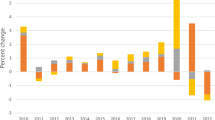Abstract
Every now and then, the OECD comes up with a devastating verdict for rich countries. Most recently: mediocre labor productivity.
Access provided by CONRICYT-eBooks. Download chapter PDF
Similar content being viewed by others
Keywords
These keywords were added by machine and not by the authors. This process is experimental and the keywords may be updated as the learning algorithm improves.
The focus on labor productivity in analyzing a country’s performance is misleading. It is even not good at assessing productivity itself. Let us ignore the concept and tackle the real problems in economic performance head on.
Every now and then, the OECD comes up with a devastating verdict for rich countries. Most recently: mediocre labor productivity.
Labor productivity is suggestive of an easily measurable concept and a suitable policy instrument. Unfortunately, neither is true. Labor productivity is simply a leftover measure after decomposing GDP into yearly hours worked, employment share, and participation rate.
While labor productivity is not the most intelligent measure to target in the first place, it is also not a meaningful concept to assess the effectiveness of a country’s labor force.
To illustrate why, let us compare two hypothetical countries. Both of their populations have the same training and inherent productivity, the same level of technology, and the same capital stock per head. There are at least three reasons why the measured labor productivity of these otherwise identical countries may diverge.
First, the integration of less productive individuals in the labor market: A country that keeps its less productive citizens employed (rather than shuttling them into transfer programs) automatically has a lower labor productivity. If the USA had an employed labor force of only Mark Zuckerberg and Bill Gates, its labor productivity would be extremely high. Would the USA be better off? No, because even though Zuckerberg and Gates are immensely productive, their income is far too low to feed the US population. However, even normal workers benefit from wider integration of less productive individuals: Their disposable income is higher because fewer taxes are required to finance transfers.
Second, different working hours: If workers are more productive in the first few hours of a workday than at the end, then the country with a longer work week automatically ends up with lower labor productivity. Which of the two countries’ citizens are better off is debatable: In economic terms, there is a trade-off between disposable income (higher in the “less productive” country) and leisure (higher in the country with the higher labor productivity); however, consumption income and per capita GDP are certainly higher in the “less productive” country.
Third, labor market participation of highly skilled workers, in particular among the elderly and women: The fewer hours well-educated individuals work, the lower is the measured labor productivity. This is, of course, a problem if highly skilled women and elderly workers stay out of the labor force, not by choice, but because high marginal tax rates, social security system’s disincentives, or missing child-care facilities prevent them from working.
Is low labor productivity then a symptom of an underlying problem in economic policy? Perhaps, but the optimal policy response crucially depends on the cause of this low labor productivity.
A much better strategy is to ignore labor productivity and tackle the real problems in economic performance head on. If there are sheltered sectors in the economy, liberalize them. If the highly skilled retire too early, give them incentives to stay on. If mothers leave the labor market, improve child care and school facilities and reduce the tax on the second earner.
Last but not least, research has shown that the feeling of “being needed” is as important for vulnerable groups of the population as material security. A lower labor productivity, thus, is the price to pay for better social integration.
Author information
Authors and Affiliations
Editor information
Editors and Affiliations
Rights and permissions
Copyright information
© 2017 Springer International Publishing AG
About this chapter
Cite this chapter
Bütler, M. (2017). (Un)Productive Labor. In: Frey, B., Iselin, D. (eds) Economic Ideas You Should Forget. Springer, Cham. https://doi.org/10.1007/978-3-319-47458-8_12
Download citation
DOI: https://doi.org/10.1007/978-3-319-47458-8_12
Published:
Publisher Name: Springer, Cham
Print ISBN: 978-3-319-47457-1
Online ISBN: 978-3-319-47458-8
eBook Packages: Economics and FinanceEconomics and Finance (R0)




